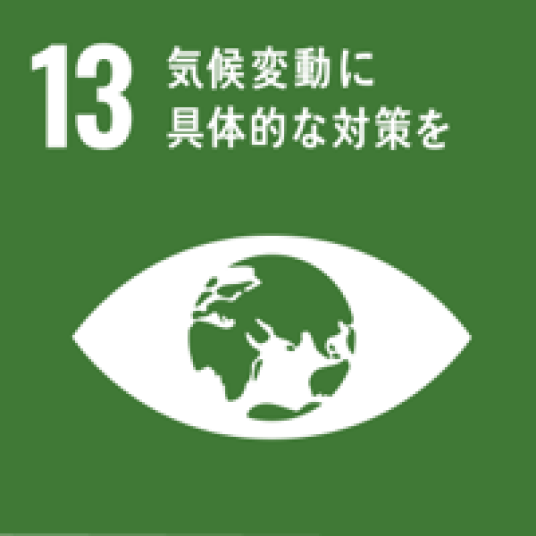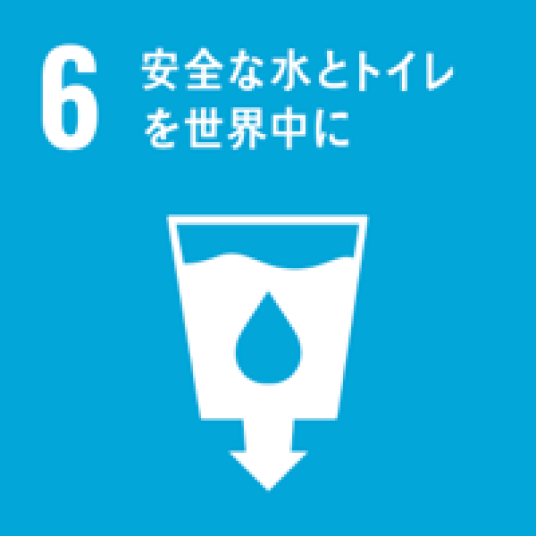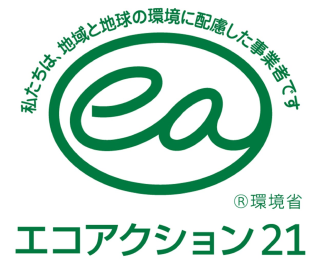Environmental Management
Environmental Management Initiatives
Goals to achieve the SDGs




Priority Issues and Details of Initiatives
| Priority Issues | Details of Initiatives |
|---|---|
| ①Climate change measures | Reduction of CO2 emissions Energy management and usage reduction Increase in green product use |
| ②Contributing to a Recycling-Oriented Society | Reduction and recycling of industrial waste Utilization of Byproducts |
As part of our environmental management efforts, in June 2019 we obtained certification under Eco Action 21, an environmental management system established by the Ministry of Environment.We have established our own environmental management policies and actions that we must take, and we are working to promote and maintain the SDGs and environmental conservation.
- Eco Action 21:Certification No. 0012812
- Date of certification/registration:21-Jun-2019(Head Office & Nara Plant)
- Date of renewal/registration:21-Jun-2023(Nagahama Plant added)

About Eco Action 21
Eco Action 21 is Japan's own environmental management system (EMS) established by the Ministry of the Environment. Japanese Ministry of the Environment has established a method for organizations and businesses to voluntarily implement environmental initiatives based on a method for continuously improving performance called the PDCA cycle. Based on these guidelines, businesses will establish, operate, and maintain an environmental management system to ensure effective, efficient, and continuous environmental initiatives.
For more information on Eco Action 21, please refer to the Ministry of the Environment's website (external link) below.
KGS Environmental Management Policy
Aiming to be an environmentally friendly food manufacturer, we will promote and maintain environmental preservation based on one of our action guidelines, "Cultivate the spirit of Mottainai" (improve yield, defective processing, process waste, and labor saving). We will also strive to purchase environmentally friendly products (green purchasing) in compliance with laws and regulations.
Actions that must be addressed
- Energy Conservation Activities
- Energy Usage Management
- Well water and wastewater quantity and quality control / Recycling
- Improvement of the environmental performance of the products we produce, sell, and provide, and improvement of our services, etc.
- Waste reduction and recycling
- Compliance with Laws and Regulations and Promotion of purchase green products.
①Climate Change Activities
Various natural disasters such as heat waves, droughts, torrential rains, and large typhoons are occurring around the world, and these disasters are said to be caused by climate change induced by global warming. To reduce CO2 emissions, which are believed to be a major cause of global warming, we are working to conserve energy and purchase green products.
Energy Management
We constantly monitor the amount of electricity and demand values with demand monitoring equipment (equipment that can check the amount of electricity used).The management company will contact you if the set demand value is exceeded. In addition, 100% of the electricity used at the Nara Plant is green power (CO2 emission coefficient of 0.00000). 0kg-CO2/kwh".
Conversion to more efficient production facilities and high-efficiency equipment
Our energy conservation team takes the lead in monitoring data from demand monitoring equipment and managing daily expenses.We are working to visualize unintentional use of electricity, gas, and other energy sources by converting electricity and gas consumption into specific energy consumption units and crude oil equivalent.In addition, we monitor the operation status of each production line, identify bottlenecks, and propose improvements.Here are some examples of improvements made to production facilities to reduce production, energy, and personnel losses.
- Installation of vaporization type gas generator
The amount of LPG (liquefied propane gas) used at our Nara Plant was large, and the electricity used by the electric vaporizer that vaporizes the LPG was also proportional. By introducing an air-heated vaporization gas generator (using atmospheric temperature), electricity consumption was reduced by 92%. - Installation of motor control equipment
Switching to inverter-controlled motors for production equipment on each production line has reduced power consumption by 24%.
Improved site environment and operational efficiency
The energy conservation team takes the lead in MMM (Muri,Muda,Mura) / MFCA (Material Flow Cost Accounting) activities to identify each production line's operating status, identify bottlenecks, and come up with improvement plans.
- Reduced product spillage (food loss) by improving equipment on the line.
- Reduction of production time by increasing capacity through replacement of machines.
- Reduction of cleaning time by improving the work environment.
- Reduction of demand values by reducing the timing of simultaneous operation of each production line, etc
②Activities Contributing to a Recycling - Oriented Society
The Basic Law on Establishing a Sound Material-Cycle Society defines a "Recycling-Oriented Society" as a society in which the consumption of natural resources is controlled and the burden on the environment is reduced as much as possible through [1] the control of waste generation, [2] the recycling of resources, and [3] proper disposal. We are committed to the effective use of limited resources and waste reduction by reducing industrial waste, recycling, and utilizing biproducts.
Recycling
We are working daily to reduce and recycle waste generated at our plants.
- Reuse of product residues (recycling rate of 90% or more)
Most of the grain scraps and other product residues generated at our plants are recycled into livestock feed, compost, and other products. The sludge generated at the wastewater treatment facility is also reused as soil and fertilizer for the zoo. - Paperless (some daily reports are now electronic)
At our plants, we keep records of all processes from receiving to manufacturing to shipping, and manage records so that they can be traced within the company. In an effort to reduce paper and simplify internal sharing, some departments are experimentally converting to electronic records by using tablet terminals. - Installation of wastewater treatment facilities and wastewater treatment
Water used at the plant is returned to the river at a wastewater treatment facility, where it is kept within the water quality standards set by the local ordinance. The activated sludge method is used as the management method, and MLSS (the amount of suspended solids in activated sludge), Do (the amount of dissolved oxygen), SV (activated sludge sedimentation rate), etc. are measured periodically. In addition, to improve the efficiency of oxygen concentration in the aeration tank, the diffuser, which is a diffuser, has been shifted to a high-efficiency type to increase treatment capacity, and other efforts are being made to manage the tank in full consideration of the surrounding environment. Some of the treated water is used for cleaning, and the sludge generated during the treatment process is reused as grass fertilizer, etc., thereby contributing to the reduction of environmental impact.
Utilization of Byproducts
By processing out-of-spec vegetables and roots, which until now have been discarded as useless, we may be able to utilize them as raw materials for food products. We are also actively involved in the reuse of byproducts generated by food factories, and are working hard to develop prototypes and commercialize byproducts.